NIOS Class 10 Economics Chapter 8 Cost and Revenue Solutions to each chapter is provided in the list so that you can easily browse through different chapters NIOS Class 10 Economics Chapter 8 Cost and Revenue and select need one. NIOS Class 10 Economics Chapter 8 Cost and Revenue Question Answers Download PDF. NIOS Study Material of Class 10 Economics Notes Paper 214.
NIOS Class 10 Economics Chapter 8 Cost and Revenue
Also, you can read the NIOS book online in these sections Solutions by Expert Teachers as per National Institute of Open Schooling (NIOS) Book guidelines. These solutions are part of NIOS All Subject Solutions. Here we have given NIOS Class 10 Economics Chapter 8 Cost and Revenue, NIOS Secondary Course Economics Solutions for All Chapters, You can practice these here.
Cost and Revenue
Chapter: 8
MODULE 3: PRODUCING GOODS AND SERVICES
TEXTBOOK QUESTIONS (SOLVED)
INTEXT QUESTIONS 8.1
Q.1. Name the payments made by the farmer to the factors of production.
Ans.
| Name of Factor | Name of Payment |
| 1. Labour. | 1. Wages. |
| 2. Service of Tractor. | 2. Rent. |
| 3. Land. | 3. Rent. |
Q.2. Who bears cost?
Ans. The producer bears cost.
INTEXT QUESTIONS 8.2
Q.1. If 48 units of output are produced and the total fixed cost is ₹ 180 along with a total variable cost is ₹ 300, what would be average cost of production?
Ans. Total Cost = TFC + TVC
= 300+180=480
Units Produced = 480

Q.2. Define fixed cost.
Ans. It is defined as the expenditure on the fixed factors of production. It does not change with the change in the level of output.
Q.3. Let output increases to 49 units in Question 1 due to which total variable cost increases to 307. What is the marginal cost?
Ans. Total cost of 48 units = 480
Total cost of 49 units

INTEXT QUESTIONS 8.3
Q. A seller sells one quintal of wheat. The price of wheat is ₹ 15 kg. What is the Total Revenue?
Ans. Total Revenue
= Price × Quantity
= ₹ 15 × 100 = ₹ 1500
INTEXT QUESTIONS 8.4
Q.1. What is the difference between average revenue and price of the good?
Ans. Average revenue = Price of the good
Q. 2. How are total and average revenue related?
Ans. Total revenue is the produce of average revenue and quantity of goods sold.
INTEXT QUESTIONS 8.5
Q. If output is 50 units, price per unit is ₹ 10, fixed cost is Rs. 110 and variable cost is ₹ 150, what is the amount of profit?
Ans. Total Revenue
= Price × Units of commodity
= ₹ 10 × 50 = ₹ 500
Total Cost = Fixed cost + Variable cost
= 110 × 150 = ₹ 260
Profit = TR – TC
= ₹ 500 – 260 = ₹ 240
TERMINAL EXERCISE
Q.1. Give the difference fixed cost and variable cost.
Ans. Fixed cost is defined as the expenditure incurred on hiring or purchasing of fixed factors/inputs which are compulsory and has nothing to do with the amount of production of the goods or services.
On the hand variable cost is the expenditure which is incurred on variable factors/inputs (such as labour) which can be
Q.2. Give the difference between explicit cost and implicit cost.
Ans. Explicit cost is defined as the money expenditure incurred by the producer for production whereas implicit cost is the cost of self-supplied factors.
Q.3. How can you calculate total cost and average cost?
Ans. Total cost is the calculated by adding total fixed cost and total variable cost, whereas average cost is calculated by dividing total cost with total output.
Q.4. How can you calculate total revenue and average revenue?
Ans. (i) Total revenue is calculated by multiplying price with total units of a commodity sold. In equation,
Total Revenue = Price × Units of a commodity sold
(ii) Average revenue is calculated by dividing total revenue by total units of a commodity sold. In equation,

Q. 5. Give the difference between revenue and cost. Why the producer must calculate them?
Ans. Revenue is the amount a person receives by selling certain quantity of the good at a given price whereas cost is the expenditure incurred to produce a good or during the production process.
The producer must calculate cost and revenue to know the profit.
SOME IMPORTANT QUESTIONS FOR EXAMINATIONS
VERY SHORT ANSWER TYPE QUESTIONS
Q.1. How does fixed cost behave with the change in output?
Ans. Fixed cost remains constant with the change in output.
Q.2. Give one point of difference between fixed cost and variable cost.
Ans. Fixed cost remains the same whether output is zero or maximum, whereas variable cost is zero when output is zero.
Q.3. Give two examples of fixed cost.
Ans. (i) Rent of a house.
(ii) Wages of permanent staff.
Q.4. Give two examples of variable cost.
Ans. (i) Cost of raw materials.
(ii) Wages of casual labourers.
Q.5. One component of total cost is fixed cost. What is the other component?
Ans. The other component is variable cost.
Q.6. Out of variable cost and fixed cost, which is zero at the zero level of output?
Ans. Variable cost.
Q.7. Define explicit cost.
Ans. Explicit cost is defined as the money expenditure incurred by the producer on both fixed and variable factors of production and raw materials.
Q.8. What is implicit cost?
Ans. Implicit cost is the cost of self-supplied factors.
Q.9. What total cost?
Ans. Total cost is the sum total of fixed cost and variable which are given explicitly.
Q.10. What is average cost?
Ans. Average cost is the ratio of total cost to the total output. It is the cost per unit. It is calculated by dividing total cost by units produced.
Q.11. Suppose a tailor makes 10 shirts by incurring ₹ 110. Calculate the average cost.

Q.12. What is marginal cost?
Ans. Marginal cost is defined as increase in the total cost due to increase in one extra unit of output.
Q.13. Total cost of 10 shirts is ₹ 1110 and total cost of 11 shirts is ₹ 1199. Calculate the marginal cost.
Ans. Marginal Cost

Q. 14. What is Revenue?
Ans. Revenue is defined as the amount a person by selling a certain quantity of the commodity. It is calculated by applying the following formula:
Revenue = Price the commodity × Quantity of the commodity
SHORT ANSWER TYPE QUESTIONS
Q.1. Find the fixed cost and variable cost from the following data:
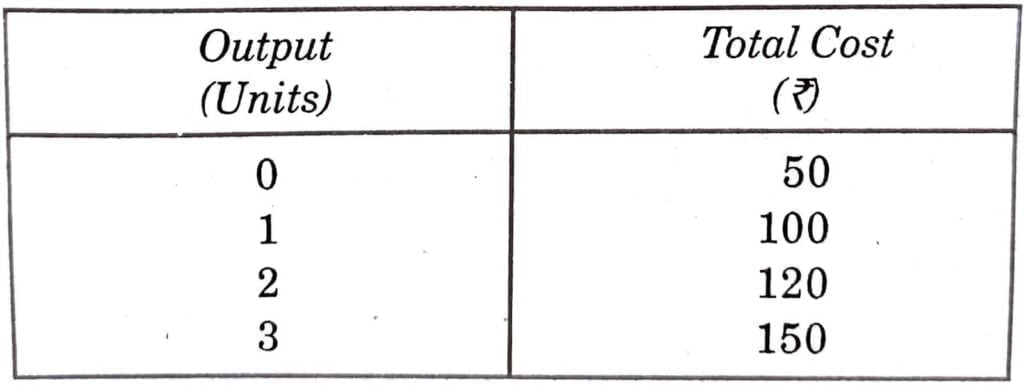
Ans.

Q.2. Calculate variable cost of fixed cost is 60.

Ans.

Q.3. Calculate total cost from the following table of fixed cost is ₹ 60.

Ans.
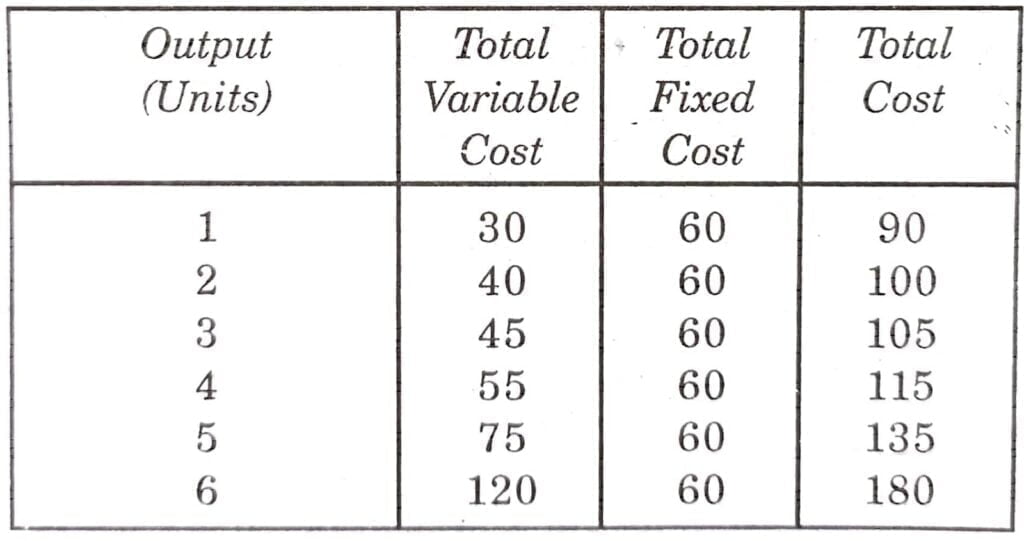
Q.4. Calculate average cost from the following data:
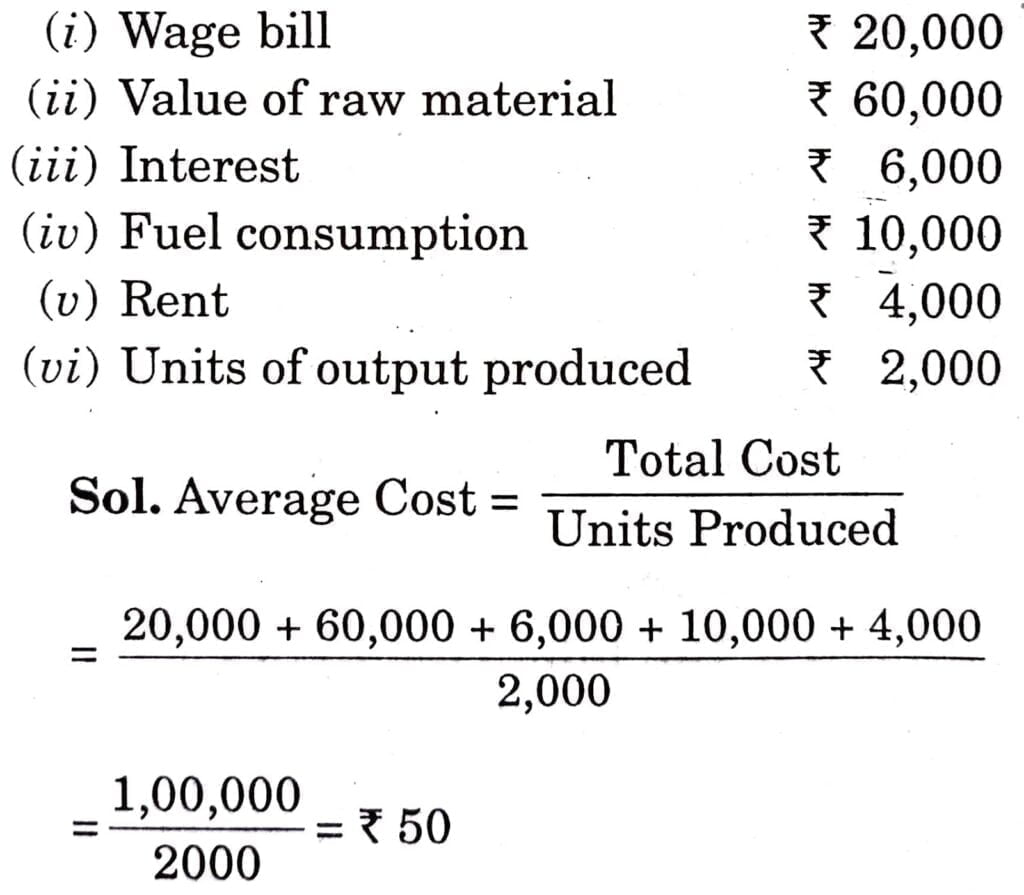
Q.5. Calculate profit from the following information:
| Items | Expenditure (₹) |
| 1. Rent paid to landlord. | 5,000 |
| 2. Wages to labour. | 31,500 |
| 3. Raw materials. | 3,000 |
| 4. Service of tractor. | 2,500 |
| 5. Revenue. | 45,000 |
Ans. Profit = Revenue – Total Cost
Total Cost = 5,000 + 31,500 + 3,000 + 2,500 = 42,000
Revenue = 45,000
Project = 45,000 – 42,000
= ₹ 3,000
Q.6. Write the steps involved in the production process of rice.
Ans. The production process of rice involves the following processes:
(i) Getting a land for cultivation.
(ii) Using labour to prepare land and make it suitable for growing the crops. It includes tilling the soil, sowing seed, fertilizing and irrigating the land and finally harvesting.
(iii) Transporting rise to godown/mandi.
Q.7. Identify the explicit cost and implicit cost.
(i) A farmer hires workers and gives them wages.
(ii) He uses his own tractor.
Ans. (i) Wages paid to workers are explicit costs because payment has been made to the worker.
(ii) Rent of the tractor is implicit cost. He could have earned rent if he had given it on rent.
Q.8. Calculate average and marginal costs from the following data:

Ans.
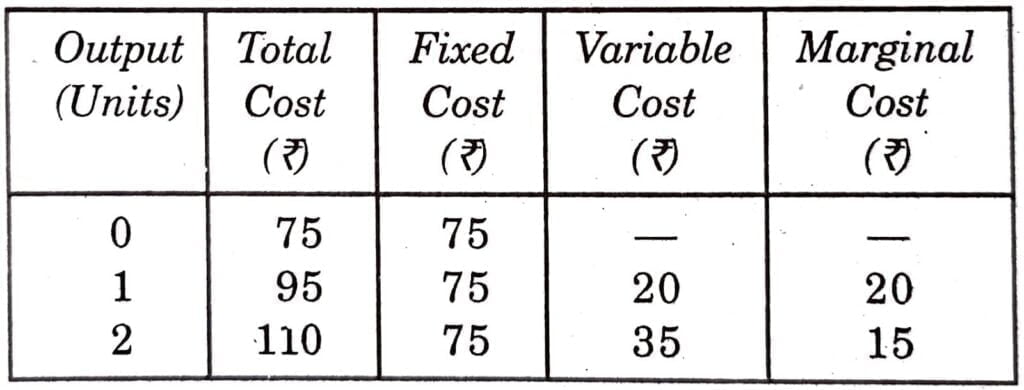
Q.9. An individual is both the owner and the manager of a shop taken on rent. Identify implicit cost and explicit cost from the information.
Ans. (i) Salary of the manager is implicit cost.
(ii) Rent of the shop is explicit cost.
Q.10. A producer starts business by investing his own savings and hiring the labour. Identify implicit cost and explicit cost from this information.
Ans. (i) Interest on the investment of his own savings by a producer is explicit cost as he would have earned interest on his savings if he had lent them.
(ii) Wages to the labour is explicit cost as the factor payment is made in money.
Q.11. A farmer takes a farm on rent and carries on farming with the help of family members. Identify explicit cost and implicit cost from this information.
Ans. (i) Rent of the farm will be explicit cost as it is the factor payment made to the owner of land in money.
(ii) Wages of the farmer and his family will be implicit costs as they would have got wages if they had worked in the farm of others.
Q.12. A person borrows and opens a shop. The shop premises is owned by him. Identify the implicit cost and explicit cost from this information.
Ans. (i) Interest on borrowed money is explicit cost because interest is paid to other (lender of money).
(ii) The rent of the shop premises owned by the shopkeeper is implicit cost, because rent is not paid to the owner. The owner could have given his shop on rent to others.
Q.13. A person invests his own savings in starting a business and employs a manager to look after it. Identify the implicit and explicit costs from this information.
Ans. (i) Interest on the capital (savings invested) is implicit cost because interest is not paid to the owner.
(ii) The salary of a manager is explicit cost because salary is paid to other (manager).
Q.14. Calculate TR, AR and MR from the data given below:
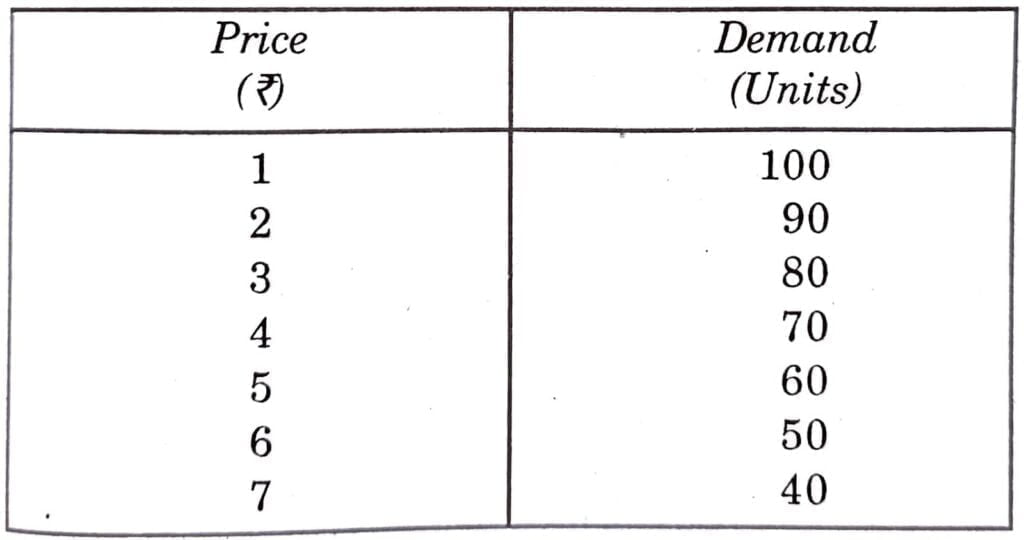
Ans.

Q.15. A farmer needs labourers to work on his field. He hires labourers in the first two months. The wage rate is ₹ 75 per worker per day. Then he uses only two workers for next two months. He employs 4 workers for the next 15 days. Calculate the total wages paid by the farmer.
Ans (i) Wages of – workers for two months
= 4 × 60 × 75
= ₹ 18,000
(ii) Wages of 2 workers for two months
= 2 × 60 × 75 = ₹ 9,000
(iii) Wages of 4 workers for 15 days
= 4 × 15 × 75 = ₹ 4,500
Total wages paid by the farmer
= 18,000 + 9,000 + 4,500
= ₹ 31,500
Q.16. Calculate Price (AR) and TR from the following table:

Ans.

Q.17. Give any six examples of fixed cost.
Ans Four examples of fixed cost:
(i) Rent of a factory building.
(ii) Salary/Wages of permanent employees of an office.
(iii) Interest on capital.
(iv) Insurance expenses.
Q.18. Give any four examples of variable cost.
Ans. Four examples of variable cost:
(i) Raw material expenses.
(ii) Wages of temporary workers.
(iii) Excise duty.
(iv) Fuel expenses.

Hi! my Name is Parimal Roy. I have completed my Bachelor’s degree in Philosophy (B.A.) from Silapathar General College. Currently, I am working as an HR Manager at Dev Library. It is a website that provides study materials for students from Class 3 to 12, including SCERT and NCERT notes. It also offers resources for BA, B.Com, B.Sc, and Computer Science, along with postgraduate notes. Besides study materials, the website has novels, eBooks, health and finance articles, biographies, quotes, and more.



